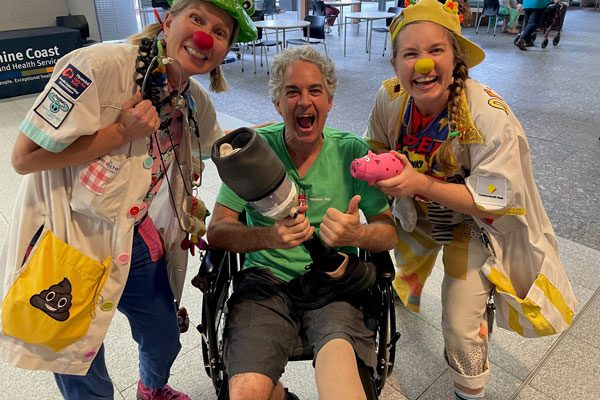
RBWH Patient Wes Raddysh (centre) is grateful for his new prosthetic leg.
RBWH has become the first public hospital in Australia to trial new hydrostatic water pressure technology to cast prosthetic legs that fit more comfortably and require less adjustments, thanks to an RBWH Foundation grant.
For trial participant, Wes Raddysh, a better fitting prosthetic leg has not only improved his mobility but also helped him regain employment and secure his dream job.
“When I put my new leg on, I could walk straight away. It was the Eureka moment,” said Wes.
“I had faith again that I could do something, get my life back.”
RBWH manufactures below-the-knee prostheses for about 100 patients each year, many who travel to the hospital from around Queensland, Northern New South Wales and the Northern Territory.
Director of Orthotics and Prosthetics Jessica Angus said ten patients had already participated in the trial and feedback was positive.
“To give a patient, who otherwise might have used a wheelchair for mobility, the opportunity to walk is extremely rewarding,” said Ms Angus.
Prosthetic legs are traditionally cast by hand, while a patient is seated. The main limitation is the soft tissue of a patient’s residual limb changed shape while under load and standing.
“This is difficult to replicate while seated,” said Ms Angus.
During hydrostatic pressure casting, a patient stands with their affected limb inserted in a cylindrical water chamber. Pressure is then applied to the limb allowing sensitive areas, bony structures, pressure and pain points to be identified.
“The new process removes the possibility of error, allows us to fabricate the prosthetic quicker and considerably reduces the number of appointments required,” said Ms Angus.
Wes Raddysh had almost given up walking again, because of the pain caused by his hand-cast prosthetic leg. He had lost his left leg in a motorcycle accident just over a year ago, on his way to a job interview.
Thanks to his new hydrostatically cast prosthetic leg, Wes finally had that job interview and is now working as a commercial skipper for the iconic Noosa Ferry service.
RBWH Foundation CEO Simone Garske said the new leg-casting equipment was among 26 grants distributed across RBWH, STARS and other Herston institutes and centres in the past year.
“The RBWH Foundation is thrilled to now offer two grant rounds each year, doubling our patient innovation and medical research funding, thanks to the extraordinary generosity of our community of donors and fundraisers,” said Ms Garske.
“The patient care innovation and medical research being undertaken through these grants changes the lives of thousands of patients each year, not only here at Herston but also nationally and potentially internationally.”
Just weeks after undergoing hydrostatic pressure casting, Wes was walking eight hours a day and recently hiked seven kilometres.
“Since the day I nearly died, every day is a gift,” said Wes, “but without the donations to get new casting equipment for RBWH, I wouldn’t be walking around as well or as far as I am now.”
If you would like to provide the Gift of Time to help patients like Wes, please donate today at www.rbwhfoundation.com.au.